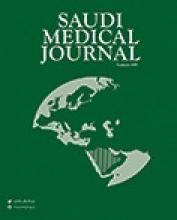Abstract
OBJECTIVE: To evaluate the prevalence of extended-spectrum beta-lactamases isolates over one year period at Sultan Qaboos University Hospital.
METHODS: We identified the ESBL isolates during a 12-month period from July 2004 to June 2005, using a commercial system, and confirmed the result using the National Committee for Clinical Laboratory Standards-approved double-disk diffusion method.
RESULTS: Sensitivity was recorded for a wide range of antibiotics, aminoglycosides, carbapenem, cephalosporins, quinolones, aztreonam, ampicillin, amoxicillin/clavulanate, ampicillin/sulbactam, piperacillin-tazobactam, trimethoprim/ sulfamethoxazole and nitrofurantoin. Of the total ESBL isolated, 29.6% were from medical ward, followed by outpatients clinic, 24.3%. Urine was the main source of ESBLs 70.4%, followed by 16.5% from blood. We observed a 100% sensitivity to carbapenems, whereas 93.9% of the isolates were susceptible to amikacin. Cephalosporins were 100% resistant, except for cefoxitin, which demonstrated sensitivity of 77.4%. Aztreonam, ampicillin, co-amoxyclav and ampicillin/sulbactam were 100% resistant. Of the isolates, 57.4% were sensitive to nitrofurantoin, whereas Tazocin showed 49.6% sensitivity and co-trimoxazole 13.9%. To quinolones, 74.8% of the isolates were resistant.
CONCLUSION: Excess use of third generation cephalosporins led to increase rate of ESBLs, which are difficult to treat. Carbapenem are most reliable for treatment of infections caused by ESBL isolates. However, overuse of carbapenem may lead to resistance of other gram-negative organisms. Therefore, justifiable use of third-generation cephalosporins, will be an effective means of controlling and decreasing the spread of ESBL isolates.
- Copyright: © Saudi Medical Journal
This is an open-access article distributed under the terms of the Creative Commons Attribution-Noncommercial-Share Alike 3.0 Unported, which permits unrestricted use, distribution, and reproduction in any medium, provided the original work is properly cited.






